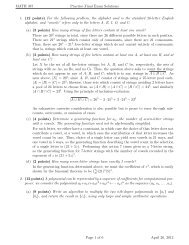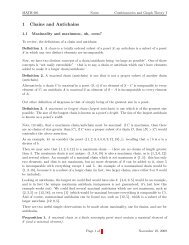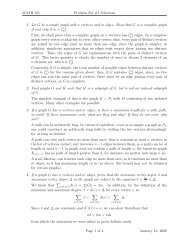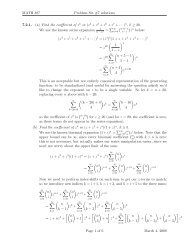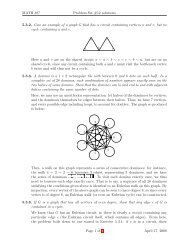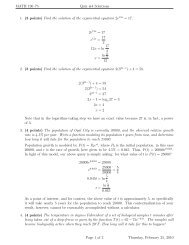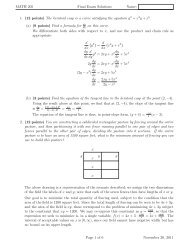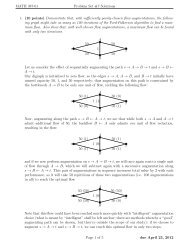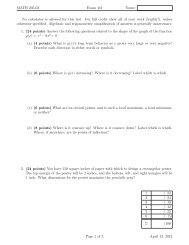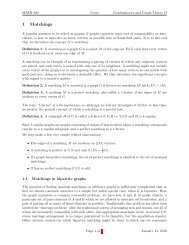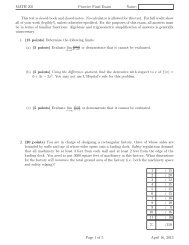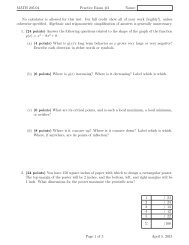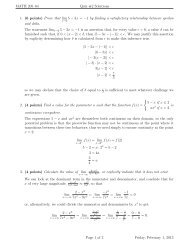MATH 180 Practice Exam #1 Solutions 1. (10 points) Let f(x)=2x2 ...
MATH 180 Practice Exam #1 Solutions 1. (10 points) Let f(x)=2x2 ...
MATH 180 Practice Exam #1 Solutions 1. (10 points) Let f(x)=2x2 ...
You also want an ePaper? Increase the reach of your titles
YUMPU automatically turns print PDFs into web optimized ePapers that Google loves.
<strong>MATH</strong> <strong>180</strong><strong>Practice</strong> <strong>Exam</strong> <strong>#1</strong> <strong>Solutions</strong>43213 2 1 1 2g(−2) = −1, as indicated by the solid dot.12lim g(x) = 4, since slightly to the left of the open circle at (−3, 4), f(x) is close to 4.x→−3− lim g(x) does not exist because of a jump discontinuity.x→−2lim g(x) does not exist, since g(x) increases without bound as x approaches 1 from above.x→1 +4. (<strong>10</strong> <strong>points</strong>) For the plot of g(x) shown below, indicate whether or not each of the followingquantities can be evaluated. If they can be evaluated, compute their values. If they cannotbe evaluated, explain why.5. (<strong>10</strong> <strong>points</strong>) Determine the domains of the following functions:(a) (3 <strong>points</strong>) f(x) = x 2 − 3x + 2.This is a polynomial, so every real number is in its domain; this could be expressed inwords, or in interval notation as (−∞, ∞).(b) (3 <strong>points</strong>) g(t) = 1t−2 + 1 t .Division by zero occurs when t − 2 = 0 or t = 0; thus, the domain must exclude the t-values of 0 and 2. Thus the domain is those values where t ≠ 0 and t ≠ 2; or alternativelyin interval notation, (∞, 0) ∪ (0, 2) ∪ (2, ∞).(c) (4 <strong>points</strong>) h(u) = √ u+2u−4 .Division by zero occurs when u−4 = 0; in addition, the square-root of a negative numberis taken when u + 2 < 0. Thus, the domain consists of those values where u ≠ 4 andu ≥ −2; alternatively, in interval notation, (−2, 4) ∪ (4, ∞).6. (<strong>10</strong> <strong>points</strong>) Find the derivatives of the following functions:• (3 <strong>points</strong>) f(x) = 2x <strong>10</strong> − 3x + 4.Using the power rule, together with the additive and scalar-constant multiplication propertiesof the derivative, we find that f ′ (x) = 2(<strong>10</strong>x 9 ) − 3(1x 0 ) + 4(0x −1 ) = 20x 9 − 3.• (3 <strong>points</strong>) f(x) = 4 x − 2 x 3 .If we rephrase this as f(x) = 4x −1 − 2x −3 , then we may use the power rule, togetherwith the additive and scalar-constant multiplication properties of the derivative, to findthat f ′ (x) = 4(−1x −2 ) − 2(−3x −4 ) = −4x −2 + 6x −4 = 6 x 4 − 4 x 2 .Page 2 of 3 February 2, 2009
<strong>MATH</strong> <strong>180</strong><strong>Practice</strong> <strong>Exam</strong> <strong>#1</strong> <strong>Solutions</strong>• (4 <strong>points</strong>) f(x) = 3 √ x + x 5/4 − 7.If we rephrase this as f(x) = 3x 1/2 + x 5/4 − 7, then we may use the power rule, togetherwith the additive and scalar-constant multiplication properties of the derivative, to findthat f ′ (x) = 3 ( 1x−1/2) + 5 2 4 x1/4 − 7(0x −1 ) = 3 2 x−1/2 + 5 4 x1/4 = 32 √ + 5 4√x 4 x.Page 3 of 3 February 2, 2009




